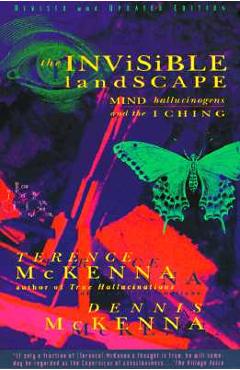The Invisible Landscape: Mind, Hallucinogens, and the I Ching, Paperback/Terence McKenna

Detalii The Invisible Landscape: Mind, Hallucinogens,
elefant.ro
120.53 Lei
129.99 Lei
Foreign Books
HarperOne
The Invisible Landscape: Mind, Hallucinogens, - Disponibil la elefant.ro
Pe YEO găsești The Invisible Landscape: Mind, Hallucinogens, de la HarperOne, în categoria Foreign Books.
Indiferent de nevoile tale, The Invisible Landscape: Mind, Hallucinogens, and the I Ching, Paperback/Terence McKenna din categoria Foreign Books îți poate aduce un echilibru perfect între calitate și preț, cu avantaje practice și moderne.
Preț: 120.53 Lei
Caracteristicile produsului The Invisible Landscape: Mind, Hallucinogens,
- Brand: HarperOne
- Categoria: Foreign Books
- Magazin: elefant.ro
- Ultima actualizare: 27-10-2025 01:24:43
Comandă The Invisible Landscape: Mind, Hallucinogens, Online, Simplu și Rapid
Prin intermediul platformei YEO, poți comanda The Invisible Landscape: Mind, Hallucinogens, de la elefant.ro rapid și în siguranță. Bucură-te de o experiență de cumpărături online optimizată și descoperă cele mai bune oferte actualizate constant.
Descriere magazin:
Chapter OneThe Figure of the ShamanOf all the diverse religious institutions that humans have elaborated since before the beginning of recorded history, that of shamanism is one of the most singular and is probably one of the most archaic as well. The shaman is something of a maverick among religious practitioners. While shamanism occurs in virtually every culture on the planet, manifesting itself in religious traditions both ancient and modern, both "primitive" and sophisticated, the shaman remains eminently individualistic, idiosyncratic, and enigmatic, standing ever apart from organized ecclesiastical institutions while still performing important functions for the psychic and religious life of the culture. Comparable, but not identical, with such similar idiosyncratic practitioners as medicine men and sorcerers, the shaman is the possessor of techniques of proven efficacy and of powers bordering on the paranormal, the complete understanding of which still eludes modern psychology. It is this complex and fascinating figure of the shaman that we want to analyze from a standpoint at once sympathetic, interpretative, and psychological, with a view to answering the following questions: (1) What are the traditional aspects of shamanism as it is encountered in primitive cultures? (2) What is the nature of the shamanic personality and abilities, and what is the psychological role of the shaman in the society at large? And (3) Are there institutions analogous to shamanism in modern society?The vocation of shaman is found in nearly all archaic cultures, from the Australian aborigines to the Jivaro Indians of central Ecuador and Peru to the Yakut tribes of Siberia. It is believed to haveoriginated among these Siberian peoples, though its diffusion into other cultures must have taken place very early in prehistory for, along with sorcerers, magicians, and priests, shamanism can be counted among the oldest of professions.The word "shaman" is derived from the Tungusic term "saman, derived in its turn from the Pali "samana, indicating a possibly Southern (Buddhist) influence among these northern peoples (Eliade 1964, P. 4951). Eliade distinguishes the shaman from other types of religious and magical practitioners primarily on the basis of his religious function and techniques: ..". he is believed to cure, like all doctors, and to perform miracles of the fakir, like all magicians, whether primitive or modern. But beyond this, he is a psychopomp, and he may also be priest, mystic, and poet." He further defines the shaman as a manipulator of the sacred, whose main function is to induce ecstasy in a society where ecstasy is the prime religious experience. Thus, the shaman is a master of ecstasy, and the art of shamanizing is a technique of ecstasy (Eliade 1964, P. 4).In archaic societies, a person (either man or woman) may become a shaman in primarily one of two ways: hereditary transmission or spontaneous election. In either case, the novice shaman must undergo an initiatory ordeal before he can attain the status of a full shaman. The initiation generally has two aspects: an ecstatic aspect, which takes place in dreams or trance, and a traditional aspect, in which the shaman is given instruction in certain techniques, such as the use and significance of the shamanic costume and drum, the secret "spirit language," the names of the helping spirits, techniques of curing, theuses of medicinal plants, and so on, by an elder master shaman. These traditional techniques of shamanism are not invariably transmitted by an elder shaman but may be imparted to the neophyte directly through the spirits that come to him during his initiatory ecstasy. Lack of a public ritual in no way implies that such traditional instruction is neglected.The ecstatic part of the shaman\'s initiation is harder to analyze, for it depends on a certain receptivity to states of trance and ecstasy on the part of the novice: He may be moody, somewhat frail and sickly, predisposed to solitude, and may perhaps have fits of epilepsy or catatonia, or some other psychological aber

Produse asemănătoare

The Invisible Landscape: Mind, Hallucinogens, and the I Ching - Terence Mckenna
![]() libris.ro
libris.ro
Actualizat in 28/10/2025
119.28 Lei

The Invisible Landscape: Mind, Hallucinogens, and the I Ching, Paperback/Terence McKenna
![]() elefant.ro
elefant.ro
Actualizat in 27/10/2025
120.53 Lei
Produse marca HarperOne

Divergent Mind: Thriving in a World That Wasn\'t Designed for You, Paperback/Jenara Nerenberg
![]() elefant.ro
elefant.ro
Actualizat in 28/10/2025
93.99 Lei

Things I Learned from Falling: A Memoir, Hardcover/Claire Nelson
![]() elefant.ro
elefant.ro
Actualizat in 28/10/2025
144.99 Lei

Peak Mind: Find Your Focus, Own Your Attention, Invest 12 Minutes a Day, Paperback/Amishi P. Jha
![]() elefant.ro
elefant.ro
Actualizat in 28/10/2025
137.99 Lei

Hear Yourself: How to Find Peace in a Noisy World, Hardcover/Prem Rawat
![]() elefant.ro
elefant.ro
Actualizat in 28/10/2025
158.99 Lei

The Conscious Universe: The Scientific Truth of Psychic Phenomena, Paperback/Dean Phd Radin
![]() elefant.ro
elefant.ro
Actualizat in 28/10/2025
93.99 Lei
